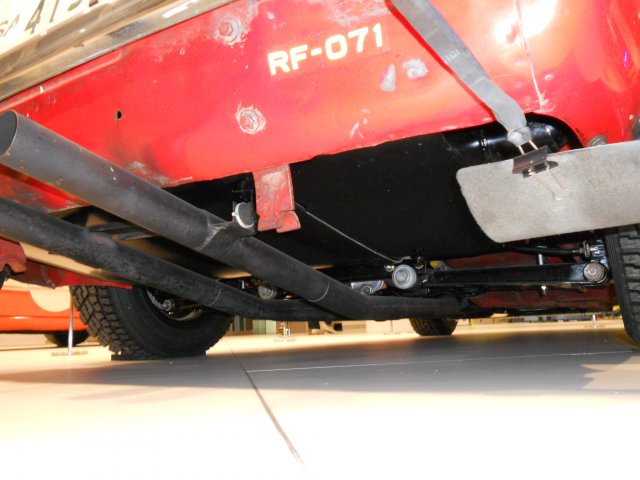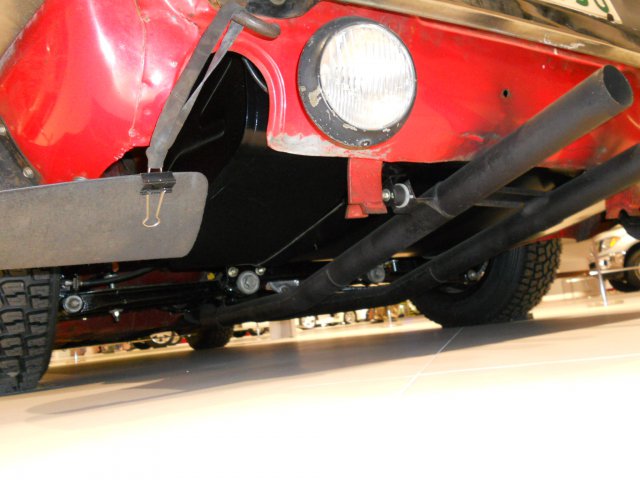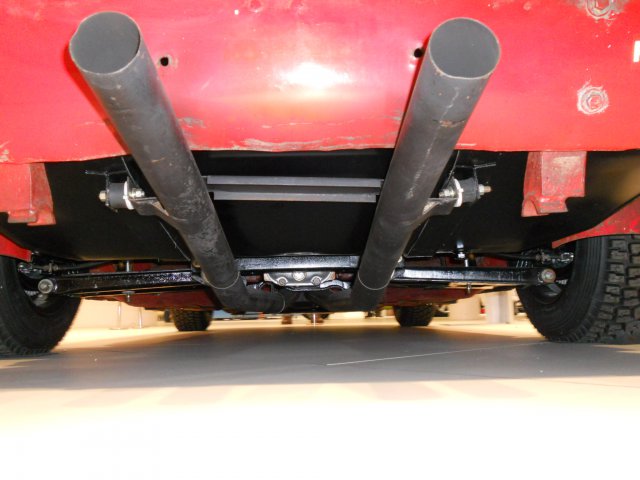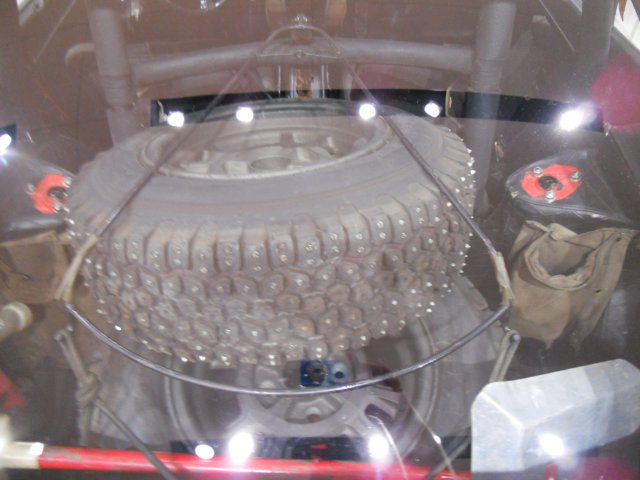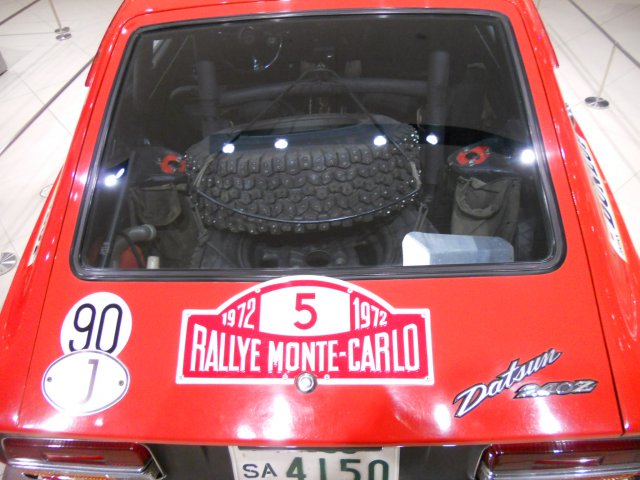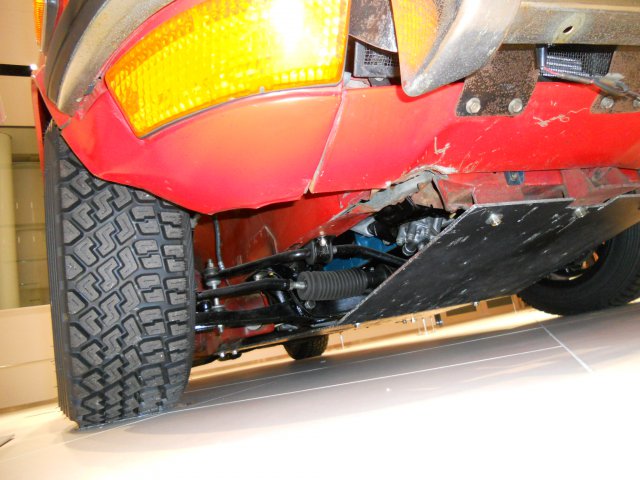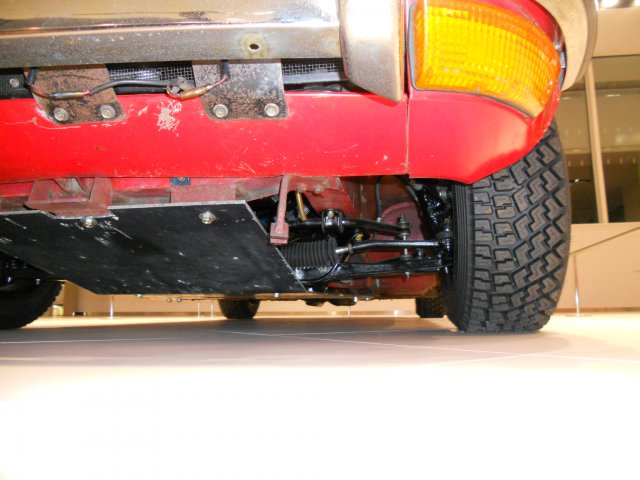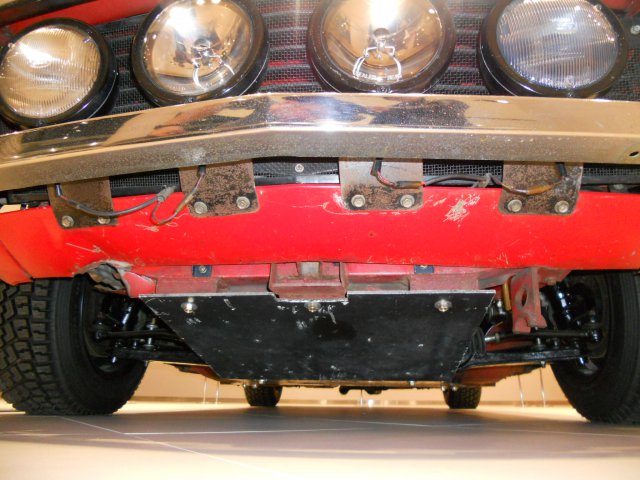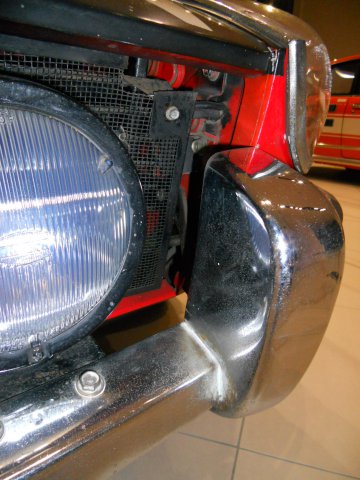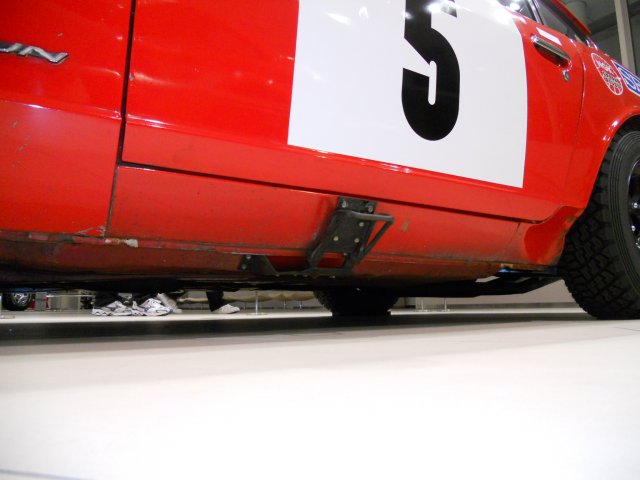-
Posts
9963 -
Joined
-
Last visited
-
Days Won
74
Content Type
Profiles
Forums
Blogs
Events
Gallery
Downloads
Store
Everything posted by Tony D
-
I loved the post recently about how someone 'discovered' the idea from a semi to put a bug screen in front of the S30's radiator to keep crap out of it... If you will notice in one of the photos of a Z-Car prepped in 1971....
-
Current tires on the car displayed at Zama (#5) and loaned to Nissan Dealers through Japan are Dunlop SP Sport-85R 185-65-14 "For Rally Use Only" directional tires (marked "Outside" and "Inside" on the sidewall)--THESE ARE DIFFERENT THAN THE STUDDED TIRES IN THE BAGGAGE COMPARTMENT, but comparably-sized. This is a cross-section of the 'under photos' I took in Lo-Res. They can come on fairly unimpeded. The high res stuff is more in detail of little bits about the car, but from these you can see they have 'dropped' the car for display--look at the droop in the tie-rods, definitely set up for a higher spring rate to lift the car than what is on there now. In these photos you can see the damage from rubbing tyres, and ripped unit-body parts from things being torn off the car at some time. You would be surprised to know how well a stock Z does off-road just stock. Lift the suspension by rewelding the perches an inch or two higher and using higher rate springs to prevent bottoming so easily and get some suspension travel dialed in and you are set with a pretty much stock car. For what you propose, your main concern will be lifting it some to prevent bottoming and protecting undercarrige from damage scraping over crap. Have a look at these photos (see their spares: two tires, a shovel, a long-travel jack, and stuff bungeed in bags all over inside the car!) and see if you get any ideas. This one doesn't need to break the bank. Remember this was a full-on-at-speed competition car. If they did it with this, there's no reason you can't as well!
-
Not with 36-38" tires he didn't. If you are going to make offhanded comments, at least be intellectually honest doing so! Brock used 7.00-LT-14's and similar sizes. Suspension travel was increased, but not to the extent that even a 30" tire would take full compression without rubbing on something. If you want to use 36/38" tires, strip the Z suspension out of it, and bolt it on a Bronco-II frame and go mudding. It's been done before. If you are going to use the Z Chassis for realistic desert running, you will have to be reasonable about tire sizing and actual compression/extension. There are things you can do to increase this travel but physical limitations within the unit body fenderwells aren't going to allow 38's. 28's maybe, possibly 30's. But you are already into the territory where at least a 4.11 is going to be necessary to run around in top gears...likely 4.38's! (But worry not, 4.62's are out there!) The photo you show as your "inspiration" most DEFINATELY did NOT use coil-overs or ANYTHING NEAR 38" tires! The Works Rally cars used a strut and spring package set up to raise the car, and ran 14" wheels. I actually have photos of not the #11 car, but of the #5 with the EXACT size wheels on it... If you can give me some time, I have them on my archive drive from last year and can maybe post details on the tires. I shot a lot of Hi-Res photos of the car and I'm not too sure on how they will work here without heavy resizing. It may just come down to me reading the sizes in my photo and telling you what it is. I have photos of the shocks with the Nissan Tag "Monte Carlo Spare" still on them and can say they were not coil overs. A simple cutting of the spring perch and raising it a set amount will give you a lift without spending a buttload of money on suspension. Remember the Works cars competed in very harsh conditions at speed with what many times appeared to be stock components. On closer examination you find thicker metal in unit bodies, or legal-within-the-rules reinforcements to standard suspension components. If you aren't stuck on total 100% factory looking tweaks things like changing your outer tie-rods to heim joints with the use of standard Tie-Rod Adapters to allow for the articulation required without binding makes your life a lot simpler! I have been in, on, and around those #11, #5 rally cars, as well as the Baja 1000 Bluebird 510 and they're not as exotic as you think. A lot of times people these days do things because the parts are available and 'it's how it's done now'---back then a lot of this didn't exist. They simply reworked stock stuff and to everybody's surprise it worked just fine!
-
"Stay Thirsty, My Friend!"
-
I think with the 40's you will have to do like the old racers did with 44's and run them without venturis. The stock engine was designed around 40PHH's and competition all used 44's. And you got incrementally more with 50's but I don't think you have the cam to handle that... So if you MUST run the 40's from "it's what's in the bin" then run them so they are like 44's to get the most from your L24.
-
Why does everybody think EFI means they can't have triples? The biggest conversion in Japan now is putting injectors in Triple manifolds, and pulling the venturis out of their carbs. They even make TPS Sdaptors that bolt right onto those Mikuini Bodies (and most other triple bodies)---pick up HP for sure, and ahem... driveability!
-
All I can say is "Control-Shift Arrow Up Up Up Up" Right Key "Control-Shift Arrow Up Up Up" Up Key "Control-Shift Arrow Down Down Down".... That is a LOT cheaper than buying all these jets, and the primary reason I went to EFI!
-
140 main should be more than enough. 135-140 was where our Bonneville Engine Ran...but like JM said with higher vacuum comes smaller jet requirements. A 220 might help on the main bleed--that is about as big as I recall seeing them in the past for most street cars. You should only change ONE JET SET at a time. If the 65's didn't change anything, but you didn't go crazy rich on your idle---then they aren't too big. If the bog still happened and didn't get better till you put the Air Bleeds in---raising it 1500 rpms---then that means now you are on the main jet when it's bogging and hitting the throttle gives you an accel shot richening it up. You might be close. A main jet larger might do it but it's late and I may have misread soemthing... But is sounds like the pilots are not causing the issue now your mains are at 3500. Really, you shouldn't be lugging the engine that low anyway...but the test of proper carburetion is to short-shift into fifth and be able to WOT the carb and have it pull (albeit slowly at first till it comes 'on the cam') from 1000 rpms on up. If you can do that without popping, bucking and surging then the jetting and all transitions are correct. This is very similar to the free rev 'gradual acceleration test' you have been doing.
-
You have to remove your heater core, drill a hole of appropriate size, and use a LONG extension to put it in from the interior of the car. You can make a plug from a nice stainless steel "Knock Out Plug Filler" from Home Depot. They work for most larger holes that aren't being used in the firewall...
-
It was a dramatic example of what happens with pressure: 160CF you can carry on your back, or a tank that is 1M Diameter X 2.6 M Tall or thereabouts for HALF the capacity. Always get a 175 psi industrial compressor with a 80 or 120 gallon tank. Realistically the CF you actually physically can store is more than the dry calculated volume due to the higher pressure. Running your X sized tank at 100psi or running it at 125psi... Ends up being 25% more storage capacitance. And that means more time between cycles. More time between stopping your DA to recharge... I have two different 30 gallon tanks on wheels that I use identically as JSM described--make myself a "Luftzow"--fed with 1/2" or 3/4" 400psi rated Goodyear Gorilla Hose, I have a multiple QD Connector 'tree' on each one, so I have several tools hooked up at one time. Because I'm too lazy to run the same tool on the same hose... and because my blue hoses are oil free, and they don't go on the oil flooded tank!
-
Surge Brakes are a nice addition to any trailer...
-
The fine people at Gunson (those that gave us the Colortune) also make a 12V CO/HC Meter....
-
If you can access the plug, there is no need to remove the part from the car to replace it. You mean the one on the back of the head? Get some 3/4" plywood to brace against the firewall, take a 24" breaker bar with a socket that fits in the plug, and make a slight fulcrum and whap the breaker bar to drive in the new plug. It's tricky but can be done like that... I wouldn't try it on an S130! Getting it out is a bit trickier, I used a prick-punch and then lever it out with a prybar. OR You can put in some Aluma-Seal and see if it plugs it without any more trouble! Good Luck in any case!
-
AGAIN? Well, now it's sporting paint and the latest buzzwords to peddle it to someone else!
-
FYI: It takes FOREVER for my little 1HP Speedaire on the 30 gallon tank to fill the big tank (300 gallon) to 125psi. But I have a digital pressure switch that I can set cut in and cut out by the 0.1psig. So by running a 5 psi differential, I can run most ANYTHING at my place all day long with the 1HP compressor given the tank size and pressure drop. The tank takes forever to pump up, but once up, and with a 5psi differential it will pump that in about 10 minutes run time with LOOOOOONG pauses in between. A 300 gallon tank is around 50 Cubic Feet (remember the SCUBA Tank size, which is 80 CF, but at 3000psi--more pressure, smaller tank.)---two stage regulation is common in SCUBA, and industrial systems. My 7HP pumps the Tank up in considerably less time, so if the kids have sucked the big tank down over a weekend.... I'll usually pump up with the 7HP then swap over to the 1HP Speedaire for what I need. The only time I really 'need' the 7HP is when I'm heavily using my grinders and spraying a big car. Or using the large nozzles on my sandblaster. In that case, I hook up the Diesel and just run it to the big tanks (in tandem for 600 gallons capacity...) Yeah, having a big truck and access to customers saying "can you get rid of this for me?" comes in handy sometimes! Yes, I have a diesel compressor--I am diseased!
-
Biggest bottleneck is line size, and reserve capacity (tank size)... Most of this is due to not using a regulator. Using air at full tank pressure sucks it down quickly. Regulating, if done, usually is through a dinky regulator totally inappropriate for something with usage requirements of a 1/2" Impact. As stated, the shorter the hose, the lower the losses. But it doesn't make sense to run a 3/8" hose from receiver to receiver and a 1/2" hose from point of use receiver to tool. You will quickly suck down the point of use tank, and then have a restriction in the transfer hose. I have an 80 gallon tank, hooked by a 1" line to a larger (300 gallon) tank simultaneously branched at a water trap to a 3/4" copper distribution system. All tanks, copper, and stainless lines operate at 125psi, the air is regulated at Point of Use. If I did it over, I wouldn't link distribution concurrently with the tank. It would go from Small Receiver to large receiver, then regulate to 100 psi for distribution with a LARGE regulator, and to tool use (35, 45, 75, 90) at Point of Use. The lower you run your air distribution network, the less you loose from leaks. It's easy to seal tanks. I routinely pump up and then shut ball valves to the large tank to keep it full virtually forever. Many people mistake the need for a 'larger' compressor because they don't have a big enough tank. There is a rule that says the bigger the tank you have, the smaller compressor you will need. You have to look at what your AVERAGE and not IMPULSE use is when sizing the compressor. You size the COMPRESSOR on AVERAGE USE. You size the TANK to the IMPULSE USE. The substitute for tank size is storing it at higher pressures (think scuba tank and what size an 80CF'er is!) For instance, in a can plant, they may have an 800HP compressor for each line and a 3400 gallon tank. In reality, when you look at the load cycling you can see it's the inrush that draws down their dinky tank when they start a line. If you put in a 10,000 gallon tank, suddenly a 600HP compressor works JUST FINE with no variations in line pressure. Now you can turn the storage pressure down from 125 to 90 psi because you no longer have a 15psi+ swing in pressure. More like 3-5psi during impulse loading. The result? The 800 HP compressor ran at 80 Amps of 4160, the 600 at 60 amps. Turning down the pressure from 125 to 90 against an 85 psi 'drop dead' requirement saved another 10 amps... well that's 30 amps at $3,450 per amp, per month.... Suddenly the cost of that new $125,000 compressor doesn't seem so bad when you pay for it in a couple of months, and after that it's all profit baby! And that, is how I pay for my bills!
-
My H4 Lights-supplied Autopal Housings have had them in there since....1995. Hasn't fried them or the wiring yet!
-
Oops! Moral of the story? Once it's even remotely on the trailer, use that stupid U-Haul safety chain at the back of the trailer to 'inch' it forward. Takes longer but it won't get away... I would have bet once it was rolling it did that, not from the ramp hump on the back---or with three guys pushing. Good to see the 'inching' method eventually worked coming down!
-
"The other difference is that the manual (5 speed) turbo ecu should have a rev limiter, as the automatic car will not." Any hard evidence this is the case? I've heard the opposite, and from what I've seen no firstgen ECU's had any sort of 'rev limiter' whatsoever. You will peg the tach if you brick the throttle.
-
Buy a set of idle screws as well The top one is trashed and will make it hard as hell to get a proper mixture (linearly) as designed. The bottom one...since there's not a sense of scale I can't readily say if that's the proper "point" -- When the break off in the idle mixture port, they are no longer "Pointy" but have a blunted end where the tip of the screw, the 'bluntness" is equivalent to the diameter of the idle port in the carb body... When you see a new one next to the other you can see one is pointy, the other blunted. I guess you could figure the extruded section of the top needle is about where it breaks off. You can see the end sticking into the air side through the idle port. But for every one that is truncated in your set: replace it. "NFG"--it's on the way to breaking off, and with the larger jets you will want all the linear, fine adjustment you can get!
-
To answer your question, NO. What your spare tank will do for you is give you capacitance. That means your pressure will hold slightly longer before it begins to decay. Beermanpete is correct: most people undersize their supply hoses and strangle the pneumatic tool. Impacts especially. What you want to do it keep your compressor tank at a high pressure, regulated down at point of use. Unfortunately it sounds like you have a 'home' compressor unit full of advertising but not big on truth in actual practice. Look for an older 5 to 7HP industrial reciprocating compressor in the classifieds or Craigslist.a 150-175psig IR 30T, Bendix, Kellog American, Quincy QRD, stuff like that. Don't worry if it's three phase---you can always change to a single phase motor. It will operate at slow speed, be pressure oil lubricated, and last forever. You can get them for a song, even with a new motor. Compared to the $1200 you would spend for a new IR or other compressor. With the higher pressure in the tank, you can effectively regulate down to near your point of use to the needed pressure. It should be a big regulator, and use a 1/2" or 3/4" hose from there to your current 26 gallon tank where you store at 100psi, and use at 90psi. The higher pressure won't decay as fast, and the little tank gives you the capacitance you need for impulse demands. When I poured my driveway, I laid a 1/2" 0.035" wall stainless steel tube through the slab. Runs from my compressor right up next to the roadway inside my fence. Comes in handy with all the kids in the neighborhood being able to fill tires when I'm not around. Nobody's stolen the chuck yet. But since I started turning off my compressor when I leave, they do come by and remind me 'there is a problem'! I like the I-R Titanium Series Impacts. Lots of marketing there, but for a WORK gun it's hard to beat. Light and powerful, but not cheap.
-
now just be ginger with those idle screws...next thing that happens is guys twist the tips off in the carb bodies and wonder why turning them has no effect on the barrel constantly popping until you really get into it! They pop out with a screwdriver, but the bummer is you have to pull the carb to get to them! You will be turning them in, that's for sure!
-
Yes, the 40's will take considerably larger pilot jets. I got 28mpg driving at 65-75 to phoenix in an L24 equipped AUTOMATIC Fairlady Z.... Keep out of the main and you run on the pilots, and that's below (generally 3K) If it won't run between 360 and 540 from seat, your pilot jets are too small. I will say if it's dying on free-rev at 2000 now, on the road it's going to COUGH BUCK SNORT! And for that, 99,999,999 times out of 100,000,000 it's pilot jets that are too small. 63.5 is my guess, but unless you get 'jet exchange' to try it incrementally up the scale you will buy one or two sets. Going too big on your first try will likely give you what you need when you put them on an L28 or put something with more vacuum in it. Good Luck!
-
Gollum, make SURE you get your BATF(E) Permit before setting up that distillery. It's a paperwork nightmare for recordkeeping (gawd forbid you make DRINK what you produce and that means you owe TAXES on it...) but without it, you're simply another moonshiner and the revenuers will come to smash your still.... When I was doing it, many old-timers were happy to see someone in the family resume production...but were upset when all I did was feed my Bus with it!


